The Successes and Failures of Sesame Street and Arthur
Most of us grew up watching the Public Broadcasting Service, or PBS. For some of us, PBS was the only channel our parents let us watch because they felt confident in the content’s cleanliness and educational value. PBS has seen its fair share of great children’s programming, from Mister Rogers’ Neighborhood and Square One to more recent offerings like Word Girl, Cyberchase, and Sid the Science Kid. Some of these programs lasted many seasons, even decades. Others didn’t last more than a season or two, though adults who watched them fondly remember their favorite shows.
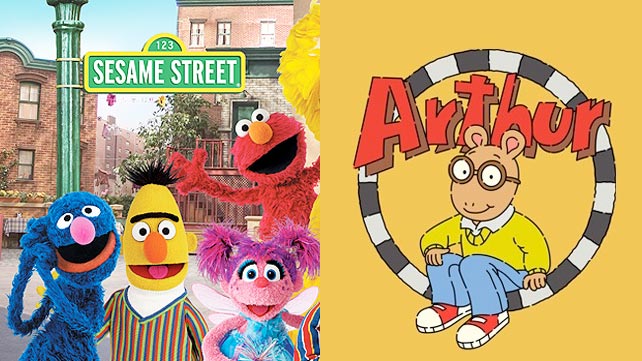
Two programs stand out among PBS’ ever-changing lineup as its longest runners. The first is, of course, Sesame Street. This beloved children’s classic has graced the air for over forty seasons with no end in sight. It has won several prestigious awards, and its Muppet characters have appeared on Good Morning America, The Today Show, and several other well-known adult programs. Its human cast members have been interviewed countless times on how Sesame Street changed their lives and the lives of others, and how the show has impacted television. The other long runner is Arthur, based on Marc Brown’s children’s book series. Arthur premiered in 1996, making it much “younger” than Sesame Street and arguably not as timeless. However, it has run for twenty seasons, and rumor has it season 21 will air in October 2017. This makes Arthur almost as old as The Simpsons, one of the most popular and enduring family sitcoms on network TV.
When a television show sticks around as long as these two have, questions naturally arise. What makes a long runner so popular? Where has it succeeded where other shows failed, even if those shows are or were similar? Did the show ever make mistakes, and what can be learned from those? Does the show have a future, or at the point it gains long runner status, is it simply coasting on its name? These questions are valid for any long runner, but more so for children’s shows. Television shows aimed at preschoolers and grade-schoolers are the first media to which we expose our children. These are the shows they will remember the longest. Along with the educational efforts of dedicated parents, children will probably learn a lot about academics and socialization through their favorite programs, because the shows are set up to repeat formulas and information, and cater to how children think. If long-running children’s shows are cancelled, the young audience will likely feel an emotional blow, and seek to fill the resulting “show hole.” Considering this, we as adults would do well to analyze what Sesame Street and Arthur have done to engage our children, as well as whether that engagement will continue.
Sesame Street
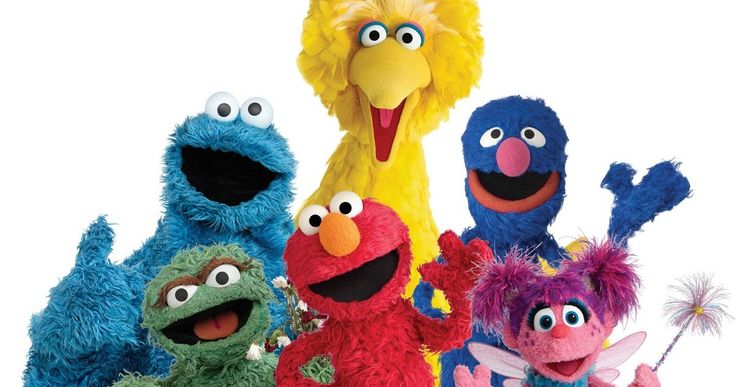
Created in 1966 by television producer Joan Ganz Cooney and Carnegie Foundation president Lloyd Morrisett, Sesame Street was unlike any other programming of its kind. The show’s goal was to produce educational content, such as letters and numbers, that would engage preschoolers. To do this, Cooney, Morrisett, and their team of experts relied on a bevy of educational, psychological, and sociological research. The Children’s Television Workshop, or CTW, produced Sesame Street, which premiered on November 10, 1969. In the pilot episode, human character Gordon is seen walking down the eponymous street with his little friend Sally. “Sally, you’ve never seen a street like Sesame Street. Everything happens here,” Gordon boasts.
Indeed, neither Sally nor anyone else had ever seen a street like Sesame Street, or a show that embraced its particular values. Sesame Street caused some controversy in its early years because it showed such a diverse cast of children and Muppets. For the first time, black, Hispanic, and Asian children were shown on television. As the show continued, other representations were added. Children who tuned in to Sesame Street got to know children from different nations, of different ability levels, and from different family backgrounds. They learned to embrace diversity from Muppets too, not just humans. Sesame Street was home to all kinds of creatures, from a nine-foot canary aptly named Big Bird to a huge, mammoth-like animal called Snuffleupagus (Snuffy for short). The street also played host to monsters with a variety of colors, heights, personalities, and quirks. Although some monsters could be scary, the species was meant as friendly – simply another part of “the neighborhood,” as a popular Sesame Street song puts it.
Not all viewers were ready for this level of diversity and tolerance. Sesame Street received some backlash, particularly for casting and representing children of color. The show was originally banned in Mississippi; the ban was lifted 22 days later but felt across the United States. Even after being touted as “an American institution” after only a handful of seasons, Sesame Street continued experiencing skepticism and backlash. For instance, the first time the cast tried to tackle the subject of divorce, the episode flopped with test audiences. Some of its celebrity guests were flops as well. Margaret Hamilton, who played the Wicked Witch of the West in The Wizard of Oz, made an infamous appearance in one 1970s episode. The episode was allegedly so frightening several parents wrote the producers to complain. In response, producers pulled the episode from rotation, and it hasn’t been seen since, including on DVD or YouTube. The beloved Muppet Count von Count was once maligned because his voice and mannerisms were far too close to that of an actual vampire. Even today, concerned parents and educators decry Sesame Street’s efforts to tackle subjects like incarcerated parents, homosexual families, and HIV/AIDS.
Success on The Street
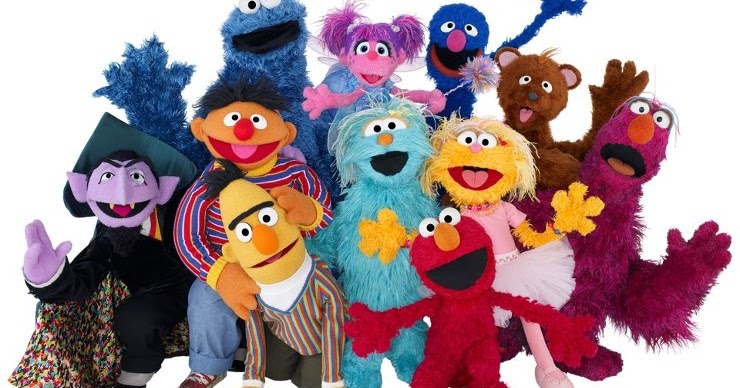
Despite some rough patches, Sesame Street evolved into perhaps the most successful preschool educational show ever conceived. Much of this was owed to its format, which continued evolving through the decades because of the show’s dedication to research. In its earliest years, Sesame Street educated its audience through short films featuring humans. Subjects of these films included things like how to milk a cow. Human cast members also participated in “street stories,” or continuing narratives that ran through each hour-long episode with “commercial breaks” for the films, sketches about numbers and letters, or Muppet sketches. Fairly early on however, the producers realized focusing too much on the human cast – mostly made up of adults – was not holding little viewers’ attention. The target audience was much more interested in the Muppets, as well as the cartoonish sketches dedicated to letters and numbers of the day. These sketches were colorful, often amusing, and usually a minute or less, ideal for a preschooler’s growing attention span. Today, nostalgic adult viewers still look up their favorite ones on YouTube or other streaming networks. Popular sketches are the “Alphabet Jungle Song,” Cookie Monster’s hit “C is for Cookie,” and sketches in which numbers drawn to look like animals or other creatures appear while being counted out loud. The 1970s also boasted a series of phonetic sketches, featuring cartoon train cars. One car would have one sound, such as the J sound, and make it while going down a track. On another track, a similarly labeled car would travel while making the sound combination “ump.” Eventually, the cars would meet to form “jump,” or whatever the sketch’s word was that day.
Sesame Street isn’t only about repetitive cartoons and simple information, though. As the show gained steam, its cast, directors, and producers gained the confidence to explore complex topics with the target audience. With the help of experts like psychologist Dulcie Singer, who worked on Sesame Street for years, the cast delved into the issues preschoolers and young grade-schoolers faced every day. Using terms and explanations kids could understand, the Sesame gang tackled sharing, kindness, trying new things, overcoming fears, and even death. One of the most famous and beloved episodes was aired in 1983, when actor Will Lee, who played storekeeper Mr. Hooper, died. Sonia Manzano, who portrayed Maria Rodriguez, explained the team decided not to bring in another actor to replace Mr. Hooper. “Why stop now?” she asked in an interview, citing the other tough topics Sesame Street had already dealt with. Therefore, the episode dealing with Mr. Hooper’s death aired on Thanksgiving Day, so that parents could be home to talk about the ramifications with their kids.
The episode focuses mostly on Big Bird, who according to Sesame Street literature represents the average six-year-old in emotions and intelligence. When Big Bird learns Mr. Hooper has died, he doesn’t understand at all what death means. In a Children’s Television Workshop interview, Sonia Manzano explained the producers used this to cover some main points they wanted to teach children about death. “They didn’t understand death was permanent,” she said. Manzano went on to say that when someone they love dies, the biggest concern children have is often, “Who is going to do for them what this person used to do?” For example, Big Bird wonders who’ll make his birdseed milkshakes and tell him stories with Mr. Hooper gone. The adults – Maria, Luis, Susan, and Gordon – step up to reassure their young bird friend his routine will remain the same. When Big Bird says death isn’t fair, and asks why Mr. Hooper had to die, Gordon gives another great response. “It has to be this way because…well, it just is,” he says. This response opened up the conversation for kids and parents who watched the episode. It gave Big Bird and the kids he represented a good answer without trying to delve into the afterlife, metaphysics, and medical reasons that might frighten kids or fly over their heads.
Such deft, creative, and gentle attention to its target audience endears Sesame Street not only to preschoolers, but older kids, teens, and adults. Most of us would never admit we still like the show, and few of us will ever sit down and watch a full episode just for fun. But talk to anyone of any age born after about 1972 and they’ll tell you they “grew up on the Street,” so to speak. Their eyes will grow soft and warm as they recall their favorite episodes and “commercials.” They’ll laugh at the footage that used to scare them, or ask, “Ugh, what were [the producers] thinking?” Entire discussion forums dedicated to these topics exist, and any Sesame Street video on YouTube is bound to have bookoos of comments unless the original poster has locked it. YouTube viewers constantly ask channel producers to upload their favorite full episodes. Adults still laugh at parodies such as Monsterpiece Theater, and search out celebrity appearances by personages like Susan Sarandon, Whoopi Goldberg, Robin Williams, and Mel Gibson. If Sesame Street‘s target audience was educated and amused, its periphery demographic of older siblings, babysitters, and parents have been engaged and positively charmed. This writer still looks up her favorite Monsterpiece sketches now and then, particularly Grover’s conquering of Alfred Hitchcock’s 39 Stairs, or One Flew Over Cuckoo’s Nest. She still gets a little shiver watching the mellow, doo-wop, and arguably creepy “Ten Commandments of Health.” Ahem…moving right along…
Sesame Street Shake-Ups
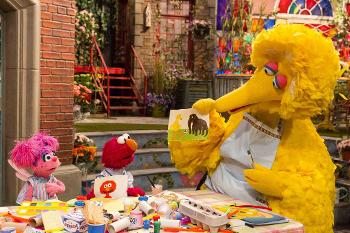 Sesame Street’s decades-long success ensured it could keep going indefinitely, but not without changes. Beginning in about 2002, those changes were keenly felt especially among the periphery demographic. The broken up “street stories,” featuring a few humans and Muppets trying to solve an over-arching problem, were completely retooled. Currently, street stories exist, but they’re self-contained, their plots resolving within five to ten minutes. Sesame Street’s new focus goes to new “mini-shows,” such as Elmo’s World and Abby’s Flying Fairy School. Again, these are self-contained and much shorter than the adults who watched Sesame in the ’80s and ’90s remember. Some, like Abby’s Flying Fairy School, have a plot, but these plots are not part of an ongoing arc; the sketch is not treated like a series. Others, like Elmo’s World, exist solely to focus on a popular character.
Sesame Street’s decades-long success ensured it could keep going indefinitely, but not without changes. Beginning in about 2002, those changes were keenly felt especially among the periphery demographic. The broken up “street stories,” featuring a few humans and Muppets trying to solve an over-arching problem, were completely retooled. Currently, street stories exist, but they’re self-contained, their plots resolving within five to ten minutes. Sesame Street’s new focus goes to new “mini-shows,” such as Elmo’s World and Abby’s Flying Fairy School. Again, these are self-contained and much shorter than the adults who watched Sesame in the ’80s and ’90s remember. Some, like Abby’s Flying Fairy School, have a plot, but these plots are not part of an ongoing arc; the sketch is not treated like a series. Others, like Elmo’s World, exist solely to focus on a popular character.
Additionally, Sesame Street has said goodbye and hello to some beloved characters over the years. Sonia Manzano has retired, leaving a huge hole where Maria used to be. Muppets and monsters like Kermit the Frog and Herry Monster have either been dropped or appear much less often than they once did. Other characters, such as Bert and Ernie, have undergone major retooling. Our two favorite Odd Couple-ish Muppets now resemble Claymation, and appear exclusively in their own shorts. New human characters such as Chris, current proprietor of Hooper’s Store, have entered the scene as well.
Whether these changes help or hurt Sesame Street depends entirely on who you ask. The current ratings indicate the target audience isn’t picky. As long as their mainstay characters like Big Bird, Grover, and Elmo are there, this Sesame Street still feels like their own. Furthermore, today’s preschoolers don’t know about features like Kermit the Frog’s Sesame Street News, cohesive street stories, Alastair Cookie and Monsterpiece Theater, or Sherlock Hemlock, parody of Sherlock Holmes. They know Abby Cadaby and her teacher, Miss Sparkle, and her friends like Gonagin. They know Elmo’s hand-drawn little house and his goldfish Dorothy. To them, Hooper’s Store is a name, not a reference to a person. Their favorite Muppet may not be a slightly neurotic blue guy named Grover, but a big, playful, yellow-orange guy named Murray. Because of their adoring kid fans, Sesame Street marches on and will likely continue to do so.
However, Sesame Street has arguably lost touch with its adult viewers in recent decades. Again, it’s impossible to say whether this is a big deal because Sesame is really for little ones. But one of the most fun parts of the show’s old incarnation was, parents and guardians could watch with children, without feeling bored out of their minds. They could get an appreciative chuckle out of parodies and spoofs. They could put their arms around their little ones and ask, “Do you feel how Maria, Luis, and Big Bird are feeling about [X topic?] Do you want to talk about this? Do you have questions?” Sesame‘s current incarnation switches topics and locales so quickly, these moments don’t happen. Parodies and spoofs still exist, of current shows like True Blood (True Mud) and Orange is the New Black (Orange is the New Snack). But bringing adults and kids together for an hour no longer seems high on Sesame Street‘s agenda. It hasn’t fallen as far as to tell parents, “Use your TV as a babysitter.” Yet it has lost some of its edge, its maturity, its punch. Older viewers want that back, which is why they show their children older clips on streaming networks, or look up old school DVDs. Sesame Street can keep going–maybe not for 40 more years, but certainly another 10-20, at least. The key will be revisiting some of its roots and pulling in everybody, not just households with preschoolers.
Arthur
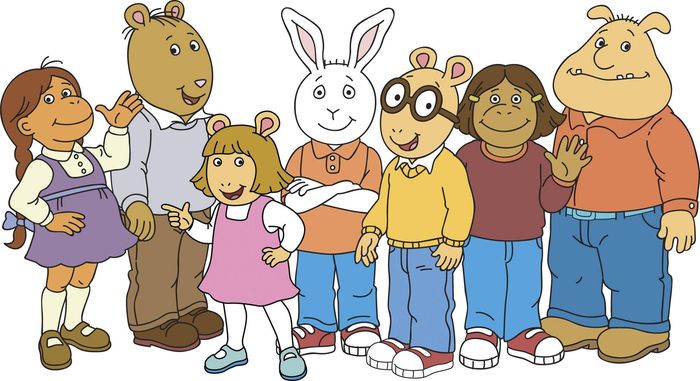
Arthur, based on Marc Brown’s beloved children’s book series, first aired in September 1996, making it twenty-one years old this year. With a large base of book plots to draw from, Arthur had a successful first season of about 30 episodes. Gradually though, Arthur and friends have branched out from their roots, as the show adds characters and tackles topics not found in the original books. Despite its title, Arthur lets us get to know many other characters besides Arthur Read. His large group of friends is well-developed and three-dimensional, as are the younger and older kids, and adults, in his life. For instance, the TV series gave Arthur an older neighbor named Alberto Molina who, while not seen in many episodes, acts as a mentor to Arthur and friends on occasion. Meanwhile, Arthur’s four-year-old sister D.W., who mainly existed to annoy him in the books, gets her own friend group and set of age-appropriate problems in the TV series.
It may be about twenty years younger, but Arthur has plenty in common with Sesame Street. It rarely uses outright parodies, but does indulge in spoofs. Many of its characters and plots contain what TV Tropes calls Shout-Outs to the teen and adult world. Other plots take their entire frame of reference from classic literature or well-known movies, such as The Wizard of Oz or Kafka’s Metamorphosis. These shout-outs and references give Arthur a more mature feel than Sesame Street while keeping the whimsy that draws in viewers for both programs.
Additionally, like Sesame Street, Arthur depends heavily on educational material. Especially in its early years, many show episodes focused on the value of reading and appreciating literature in all its genres and forms. Episodes like “Arthur’s Lost Library Book,” “The Scare Your Pants Off Club,” and “Buster Hits the Books” drove home the value of reading in a memorable but not preachy way. Later in its run, Arthur became somewhat famous for a song called “Having Fun Isn’t Hard When You’ve Got a Library Card.” Other episodes dealt creatively with subjects like history, science, and health and wellness. But unlike Sesame Street, the information presented in Arthur is not repetitious. It doesn’t have to keep a preschooler’s attention span in mind, which gives the writers of each story more room to experiment not only with educational lessons, but plot and character development as well. These and other successes have kept Arthur going strong for years, perhaps even stronger than Sesame Street on some fronts.
What Arthur Gets Right
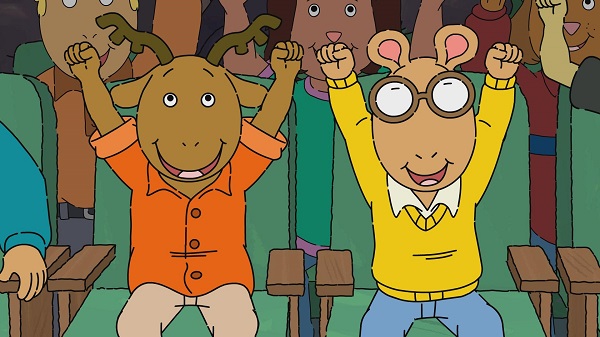
As noted, one of the main reasons for Arthur’s success is its broad target audience. Like Sesame Street, it nets a wide periphery demographic, but there is a key difference. The periphery demographic for Sesame is mostly made up of parents and caregivers who watch only when young children are present. On the other hand, Arthur has a large cult following not only with these groups, but with preteens, teens, and young adults. At one time, it was estimated Arthur’s older demographic was larger than the one for SpongeBob SquarePants. College students in particular seemed to love Arthur in the 1990s and early 2000s. Many potential reasons exist, but perhaps the biggest one is the broad range of Arthur’s characters. Within one show, viewers see points of view from eight-year-olds, four-year-olds, and occasionally older kids from age nine up to thirteen. Arthur’s adult characters are three-dimensional as well. Unlike those of Sesame Street, the adults don’t exist mainly to help kids navigate the world. Parents, teachers, and other Elwood City grownups do that, but not at the expense of their own personalities, quirks, and interests. For example, Arthur and friends’ teacher Mr. Ratburn is probably the most three-dimensional educator of children’s programming. We know he’s a hardworking and strict teacher who assigns draconian amounts of homework. But thanks to episodes like “The Rat Who Came to Dinner,” we also know this man loves cake, still watches old cartoons, and is great at sleight of hand tricks. He’s also a professional puppeteer and avid reader who, despite his brilliance in other areas, can’t navigate the Internet to save his life.
Arthur has also succeeded for twenty years because along with its broad audience base and well-developed characters, it’s highly diverse. In the past 20 years, viewers have met Jewish characters in Francine Frensky and her family. They’ve met African-Americans in Alan “The Brain” Powers and his family. Arthur’s best friend Buster has asthma, and another friend, George Lundgren, has dyslexia. At least three characters – Marina, Lydia, and Carl – have physical and emotional disabilities. Marina is blind, Lydia uses a wheelchair, and Carl has Asperger’s Syndrome. Of course, Sesame Street has plenty of diversity too, but on that show, it’s treated as part of lessons preschoolers need to learn. In other words, when a Sesame viewer sees a black, Jewish, or disabled character, he or she is meant to learn, “This person is more like you than different from you. Be kind to the people like this in your life.” On Arthur, the diversity is more mature and organic. It’s treated as a part of life and more than that, as what makes people interesting or worth knowing. Even things that characters struggle with, such as asthma or disabilities, aren’t treated as problems to be cured. They’re seen as only small instances of what sets a friend apart from the crowd.
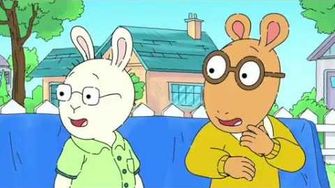 Speaking of setting people apart, Arthur is excellent at doing exactly that. Twenty years have given its writers and producers plenty of time to develop characters much further than Marc Brown did in his books. In the books, for instance, Binky Barnes is mostly a one-note bully. On the TV show, we get to see his motivation for bullying others – he’s been held back in school and feels he’s not the best at anything. Thus, he uses his size and strength, which he sees as his only assets, to intimidate classmates. However, and more importantly, Binky has become a mellower and better-developed person in the hands of Arthur‘s writers. We now know he has a gentle side, as displayed in some of his interests such as ballet, opera, and art. Recently, he became an excellent big brother to baby sister Mei Lin, adopted from China in the Season 10 finale.
Speaking of setting people apart, Arthur is excellent at doing exactly that. Twenty years have given its writers and producers plenty of time to develop characters much further than Marc Brown did in his books. In the books, for instance, Binky Barnes is mostly a one-note bully. On the TV show, we get to see his motivation for bullying others – he’s been held back in school and feels he’s not the best at anything. Thus, he uses his size and strength, which he sees as his only assets, to intimidate classmates. However, and more importantly, Binky has become a mellower and better-developed person in the hands of Arthur‘s writers. We now know he has a gentle side, as displayed in some of his interests such as ballet, opera, and art. Recently, he became an excellent big brother to baby sister Mei Lin, adopted from China in the Season 10 finale.
With each facet an Arthur character receives, the show’s creators are free to explore new plots, or new angles of old ones. Even when a character has one main interest, viewers get to see him or her grow in it if the character is seen often enough. For example, Fern Walters’ main interests are reading and creative writing. Viewers first saw her writing talent in “I’m a Poet,” when she came out of her shell to challenge the classmates who made fun of her for participating in a poetry contest. “You only make fun because you couldn’t write a poem if you tried,” Fern snaps, leading Francine to marvel, “That’s the most she’s said all year!” Fern’s classmates come to love poetry and respect her talent, giving Fern the confidence to gain social ground. Since “I’m a Poet,” viewers have seen her solve mysteries in such episodes as “Fern’s Slumber Party” and “Crime and Consequences.” They’ve cheered her on as she pursued publication in “Fern’s Flights of Fancy” and “Fern and Persimmony Glitchet” (featuring a parody of Lemony Snicket). They’ve even seen her defend fantastical stories to the sometimes uber-practical Brain in “War of the Worms,” with results that are funny but also present something of a cautionary tale. Other Arthur characters, including minor ones, get the same opportunities to shine in different episodes and seasons. Therefore, the possibilities for the show are almost endless.
Has Arthur Jumped the Shark?
Actually though, these endless possibilities might be part of what Arthur has gotten wrong in recent years. Many fans in its older demographic complain the show has jumped the shark, and they have a point. While some plots explore different angles of characters, others are downright recycled. For instance, viewers have already seen the downfalls of bullying thanks to characters like Binky and Francine, who used to be an obnoxious athlete before getting character development. Therefore, when Arthur inexplicably bullied Sue Ellen over a sweater in “So Funny I Forgot to Laugh,” older viewers, and some in the target audience, felt let down. The episode’s entire plot feels condescending, with Arthur’s friends and teacher endlessly lecturing him over a completely out of character moment. Additionally, viewers felt it was unfair and unrealistic to paint the show’s title character as a bully in any context. Some older viewers complained that Arthur and Sue Ellen could and should have worked out the conflict for themselves, as we have seen Arthur characters do before. Instead, Sue Ellen asks to switch classes, ostensibly because Arthur has reached the point of “cyberbullying” her through one insensitive email. She doesn’t make the switch, but the mere threat is enough to shake up the cast.
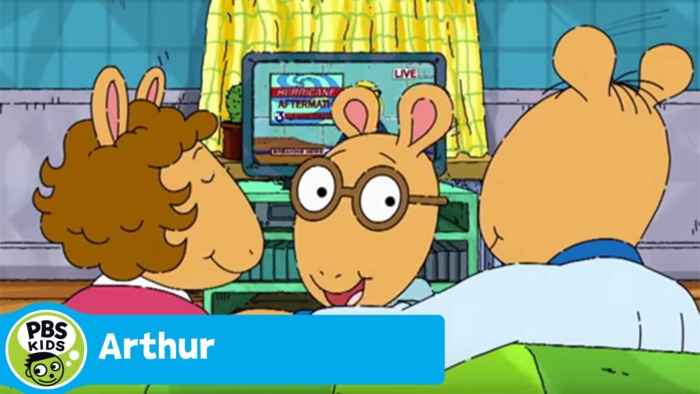
Recycled episodes are not Arthur‘s only current problem. Especially within the past 3-5 seasons, the show has become intensely issue-driven. Characters are suddenly given flaws that are invisible or that they never had before. For instance, in the episode “Arthur Weighs In,” Arthur struggles with his weight. His weight gain isn’t noticeable, and he’s certainly not living on junk food or refusing to be active. However, “Arthur Weighs In” takes every moment that its title character lazes around watching TV, or eats a snack, and hyper-focuses on them. Mr. Ratburn inexplicably gives his class pedometers and explains the federal government standard of 10,000 steps per day, while Brain lectures Arthur on healthy food choices. The entire episode feels ripped from the headlines. It’s as if the writers were told, “Okay, obesity is a major issue right now. Make a character fat so we can talk about it on the show.” Covering current issues isn’t wrong in itself. Arthur has done it well in the past with episodes like “April 9th,” based on the September 11, 2001 terrorist attacks, or “Shelter from the Storm,” wherein Brain deals with post-traumatic stress after a hurricane. Yet Arthur has gone from talking to viewers about the issues to talking down to them. One can almost expect there to be an Issue of the Week on the show, with the accompanying appropriate lectures and obvious lessons.
Finally, many viewers feel Arthur has abandoned its roots, playing with plots and characters just because it can. Most fans in and outside the target audience hated the addition of new classmate Ladonna Compson, a transfer from Louisiana who mainly acts as someone to see Elwood City through fresh eyes and provide commentary. Other fans hate the newest episodes because of changes in animation and character voices. According to some, the new Flash animation makes Arthur‘s characters and backgrounds look unrealistically colorful and downright childish, while the newest voice actor for Arthur himself sounds too much like a four-year-old girl. As with Sesame Street, the target audience may not notice or care, but these changes have made several older viewers drop out in disgust.
However, changing the animation and voices back to their original tones would not save this show. Target and periphery viewers now claim the new plots are ridiculous as well. One such episode on the docket is “Sue Ellen and the Last Page,” which deals with Elwood City’s decision to close its library and Sue Ellen’s concurrent decision to mount a protest. Viewers in countries already privy to the episode despised it. “Why would a show dedicated for years to the joy of reading close its library?” one fan asked on an Internet forum (paraphrase). Other fans don’t like the idea of Sue Ellen protesting, as we’ve already seen her do so once, when a new Chickin Lickin threatened to close the cast’s local hangout, the Sugar Bowl. Considering Sue Ellen’s other recent character development, such as her commitment to vegetarianism, she may be sliding slowly toward a caricature. Her particular character archetype would be known in TV Tropes as a Granola Girl or Soapbox Sadie. Flanderization of Sue Ellen and other characters mean Arthur’s cast may be sinking quickly.
Arthur may not last another twenty years, but its creativity and dedication to subtle education mean the program still has some life in it. The next season could be a turning point, so it’s crucial that Arthur’s creative team thinks carefully about what to do next. It’s impossible to undo many of the changes the show has undergone, such as a new animation style and new characters. However, if the writers tone down the flanderization and issue-driven content, returning instead to Arthur‘s simple, but charming roots, viewers can look forward to at least a few more years with their favorite aardvark.
The Final Verdict
Few television networks give audiences long-running shows that truly last the test of time. The Public Broadcasting Service has done what might have seemed impossible forty years ago, giving viewers not one but two classic shows that have impacted generations. Sesame Street and Arthur are at once similar and unique, and together they capture the attention, minds, and hearts of both kids and adults who watch. Both shows have made odd and perhaps ill-informed decisions with their content. Those decisions might negatively impact their trajectory in the coming years. Yet if creators revisit their roots and listen to all ages in their audience, creating new content based on what they learn, it’s likely that these programs will continue impacting families for even longer than they already have.
Works Cited:
Arthur (1996). Dir.: Greg Bailey.
Manzano, Sonia. “Sonia Manzano Discusses the Death of Mr. Hooper on Sesame Street.” Archive of American Television. Retrieved from www.youtube.com on October 3, 2017.
“Sesame Street.” Retrieved from www.wikipedia.org on October 3, 2017.
What do you think? Leave a comment.
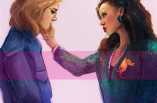
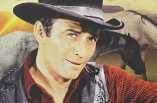




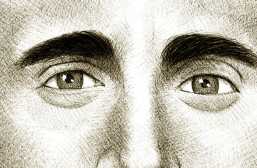

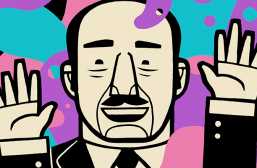
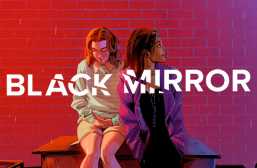

Arthur has remained my all time favorite show. I’m 14, and I’ve watched this show since it came out when I was a baby. I grew up watching this show (as well as many other PBS shows), and through every moment in my life, I can always relate to this show.
I grew up watching Sesame Street. I still remember some of the songs. Now my 1 year old daughter is watching, and learning some of the same songs.
Rarely do 2 generations have the chance to grow up learning from the same characters (with the exception of Captain Kangaroo). I get a thrill out of watching the show with my daughter because I know she is watching quality educational TV.
Sesame Street is still the best show on TV for kids, and it’s time we view it for what it is…a National treasure.
ST and Arthur is a timeless piece of Children’s TV history which will always be around for many years to come.
This was very very informative on the history and progression of Sesame Street and Arthur. Although I never experience Sesame Street in any memorable degree as a child, Arthur was a favorite of mine. I am sad to hear about some of the changes Arthur has gone through, because I was one of the people clumped in the demographic of older consumers. If Arthur was on, I was going to watch it, teenager or not. I hope they can reclaim their past charm and meaningful character development, or at least know when to stop if they can’t.
I’m an teenager and I enjoy Arthur, when I was in 2nd grade I started watching then for some reason I stopped. I wish people, especially teenagers like me would watch shows like this and wish it would air more.People nowadays like to watch trash and educational and stuff that rots your brain like South Park, The Simspons, 7th Heaven, etc.
In Canada, Sesame Street is a little different. Since 1997, it has been 30 min and is now called ‘Sesame Park’, in which takes place in a Canadian park, not on a New York Street.
When I was growing up in the early and mid 1980’s in suburban Washington, DC, me and many of my childhood friends would be watching Sesame Street. Some of the skits the adult characters as well as the muppets did are timeless gems as well as the many songs. I learned a lot from watching the show each day which always had something different.
I like the Arthur books, but I love the show. It is one of the rare instances where the show is better than the books.
This show is excellent!
Arthur is a wonderful program; I like to watch it even when my kids aren’t home.
In all truthfulness I did not like Sesame Street as a kid nor did I like my kids watching Arthur. However, I did enjoy your article immensely and may give it a second chance. Thanks for changing my mind.
😀
Everyone may think that Arthur is just a silly kids show about friendship that kids love but adults hate, but that is not necessarily true. I like this show a lot, and I know many adults that love this show.
I absolutely love this Sesame Street, and my children will hopefully grow up on it, and my children’s children will hopefully do the same–just as I have. I LOVE YOU SESAME STREET!
This show simply can’t ever end; it gave me something to watch when I was younger, and it allowed me to be so ahead of my classmates when I went to kindergarten and all through elementary school, really.
Sesame Street is a very excellent show for little children to watch and learn.
It is a show that you can never be too old for.
My favorite muppet characters are Ernie, Bert, Big Bird, and Kermit the Frog, who I knew from the Muppet Show.
Kermit the Frog, Miss Piggy, Big Bird, Oscar the Grouch, the Count are my favorites.
I always loved Sesame Street and all the characters. I am 91 now and look forward to the film.
I used to watch Sesame Street when I was a little girl. When I think about it, I remember it pretty well. However, I remember the opening sequence and theme song pretty well. If you ask me, it was a good show which is very educational.
Born in 1978 thru the years I might from time to time would catch reruns of “Sesame Street” on TV or on “PBS” watching mostly for fun to see “Big Bird”. And as with time things change as now the series has went to premium cable giant “HBO” and it’s still the same old liked and lovable series that’s fun, upbeat and entertaining with great characters.
Sesame Street is never gonna end it’s been on television for years now and i think it’s a good show for children at any young age to watch!
This article is superb.
One of the best cartoons ever made.
Really interesting article. Although I watched Seasame Street in my early years, I must admit to having never given it any thought at all. It was really interesting to read the issues of diversity it faced and presented. A great discussion!
As someone who watched Sesame Street growing up, and perceiving those controversial episodes as normal, it is interesting to read how it was received by adults at the time and situate my own development in the sociopolitical landscape… an important practice which should be ongoing, but which is hard to do without resources like these. 🙂 Thank you.
It’s sad to hear that Arthur has become preachy. Growing up, I always hated any media that had too overt of a message. Hope they can do some of the fun, plot-based episodes like they used to. The earliest seasons (1-6) that I watched as a kid will always be in my heart though. Got some SERIOUS nostalgia trips rewatching them a few weeks ago.
This article was like taking a walk down memory lane. I think that the diversity, educational material offered, and the creativity and insight to tackle real world problems has helped both shows to be exceptional and long running.
Wow i never new the details of these shows, my favorite was Arthur, and yes it appealed to me when i was older. As for sesame, when i was younger but now i find sesame to be enjoyable as i watched an episode with my little sister. It is although, enjoyable to an extent.
A good essay. I always enjoyed watching Sesame Street with my kids, it helped me to teach them counting and the alphabet.
I think this was one of the moments on Arthur that is underrated as one of the worst (so much so that it’s a meme today (Arthur with headphones)): https://i.kym-cdn.com/entries/icons/original/000/023/308/Screen_Shot_2017-06-27_at_2.10.37_PM.png
I think one of the moments on Arthur that is underrated as one of the worst was Arthur with headphones (though more of an animation failure). So much so that it is now a meme. See Arthur with Headphones on Know Your Meme for further details.